8 Foods High in Zinc That Support a Healthy Immune System
A dozen oysters, please!
When it comes to immune-boosting nutrients, zinc usually tops the list as one of the best. And it’s no wonder with how zinc supplements have been flying off the shelves in recent years—but supplements aren’t the only (or always the best) option when looking to increase your daily zinc intake. There are so many healthy, natural, accessible food sources of zinc to choose from. Here’s how zinc helps to bolster the immune response and support overall health, plus the best zinc foods to stock up on at the grocery store.
Related: Fortify Your Immune System With These Healthy Foods High in Quercetin
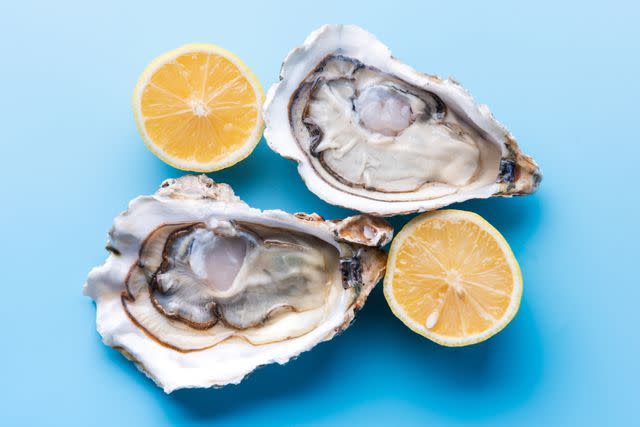
HUIZENG HU/Getty Images
Zinc Health Benefits and Functions
Zinc can help to strengthen your immune system, shortening the amount of time you’re feeling under the weather. While technically a metal, this mineral is considered an essential nutrient, which means the body cannot produce it on its own, thus requiring us to consume it through either food or other external supplementation.
When it comes to the health benefits of zinc in the body, its influence spans wide and far. It’s present in each of our cells as the second most abundant mineral in the body (after iron), where it carries out a multitude of roles. Some of its most noteworthy jobs:
Zinc is required for the action of over 300 enzymes in the body that aid in nerve function, digestion, metabolism, smell, and taste.
It’s required for protein and collagen formation, illuminating why it’s so effective at speeding up wound healing.
It plays a vital role in the functioning of several types of immune cells in the body, springing the immune system into action.
Zinc is even important for the formation of DNA and healthy cells within the body, facilitating healthy growth and development.
As an antioxidant, zinc works to eliminate oxidative stress and molecules, like free radicals, that promote inflammation and disease in the body.
Related: 3 Foods That Undermine Your Immune System
When it comes to research surrounding this essential mineral, there’s no shortage of impressive findings.
When it comes to research surrounding this essential mineral, there’s no shortage of impressive findings. Here are the highlights:
Aging: This micronutrient is vital as we get older. One review found that zinc supplementation can help slow the signs and symptoms of aging in older adults. It may also be tied to a decreased risk for degenerative diseases including age-related macular degeneration.
Respiratory Symptoms: Whether it be a cold or full-blown respiratory infection, zinc is effective against a whole host of respiratory symptoms. A systematic review found that zinc supplementation can shorten or even prevent respiratory tract infections in adults. Evidence also shows this immune-boosting mineral to be powerful against cold symptoms, with zinc supplementation within 24 hours of the first inklings of a cold reducing symptoms and severity.
Metabolic and Heart Health: When it comes to managing the blood sugar and lipid levels that can contribute to metabolic and heart conditions like type 2 diabetes and heart disease, zinc is also impactful. In fact, one meta-analysis found that zinc supplementation was associated with lower blood lipid levels in individuals with type 2 diabetes. In women with gestational diabetes, zinc was also associated with lower fasting glucose levels and insulin resistance.
Cancer: While a generally recognized anti-cancer agent, zinc has also been effective against specific types of cancer, including leukemia.
Spinal Cord Health: Interestingly, zinc has even been found to be powerful in expediting the healing of spinal cord injuries, while also working to maintain the general health of this vital structure in the body.
Diarrhea: Finally, this mineral has been linked with improvement in the most common tummy troubles including vomiting and diarrhea, especially in children.
How Much Zinc Do You Need?
The recommended daily allowance (or the amount to aim for) is 8 milligrams (mg) for adult women and 11 mg for adult men. The tolerable upper limit for zinc consumption is 40 mg per day, which is pretty difficult to achieve. When we get much beyond this amount on a somewhat regular basis, we may experience negative impacts like nausea, diarrhea and headaches as well as impaired copper, iron, and magnesium absorption (zinc can inhibit the absorption of these when consumed in excessive amounts).
Many people across the country (and the globe) aren’t getting enough of this essential micronutrient. In fact, zinc deficiency has been observed in nearly 17% of the global population, increasing their susceptibility to infection. Telltale signs of zinc deficiency include poor appetite, reduced taste or smell, depressed mood, hair loss, diarrhea, and decreased immunity and wound healing. Those most at risk for deficiency include those who are pregnant, anemic, or have chronic kidney disease, since zinc needs are increased with these conditions. It’s also important to note that those following a plant-based diet are at a slightly higher risk for deficiency because, while there are plant-based sources of the mineral, its bioavailability is lower in plant food sources than in animal-based options.
The best way to prevent deficiency and reap all these extraordinary benefits is, unsurprisingly, to ensure you’re consuming enough zinc everyday—and these options can help you get there.
Foods High in Zinc
1. Shellfish
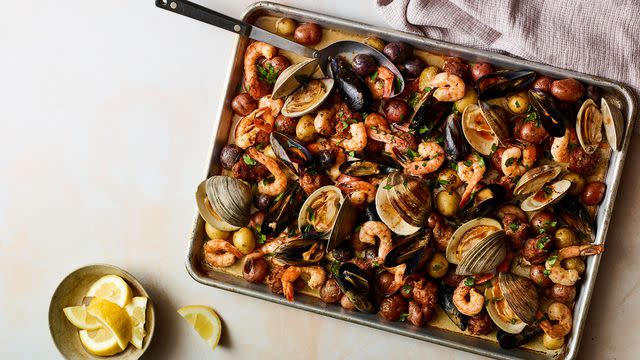
Beyond making for delicious pasta, paella, and soup additions, shellfish are also full of nutrition, including our beloved zinc. Oysters are far and away the best dietary source of zinc you can find, blowing all other sources out of the water with up to a whopping 32 mg of the mineral per three ounce serving. Crab and shrimp are great zinc sources (though offering far less compared to oysters), measuring in at around 3 and 1.5 mg per three ounce serving, respectively.
2. Nuts and Seeds
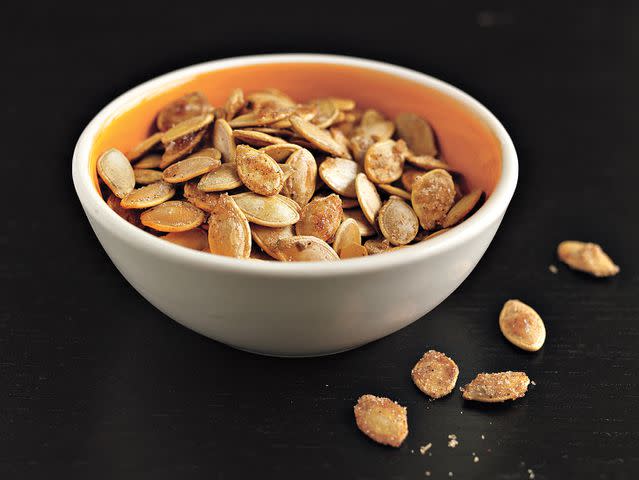
Sweet and Salty Pumpkin Seeds Recipe
On the plant-based side, nuts and seeds can also offer notable amounts of zinc. One ounce of pumpkin seeds boasts 2.2 mg, and the same amount of peanuts contains about 0.8 mg. The sky’s the limit with the delicious culinary possibilities for these nutty favorites including trail mix, PB&J sandwiches, salads, baked goods, and many others.
3. Eggs

Potato Omelet With Smoky Aioli Recipe
Eggs are not only tasty and satisfying, but offer tons of important nutrients. One large egg offers 0.6 mg of this coveted mineral, along with plenty of protein, vitamin D, and choline.
Related: 8 Delicious Ways to Use Up All Those Extra Eggs in Your Fridge
4. Whole Grains
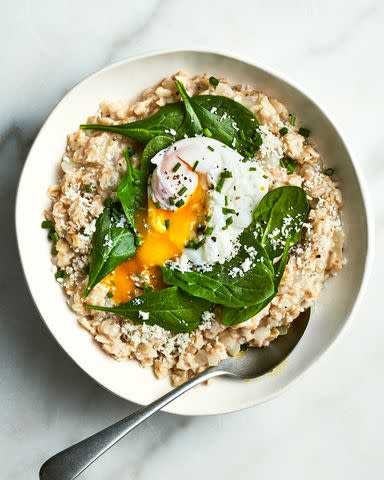
Savory Oatmeal With Spinach and Poached Eggs Recipe
The fiber in whole grains helps regulate digestion, manage cholesterol levels, and keep you satisfied throughout the day. Beyond fiber, these grain and cereal options include important micronutrients, including zinc. While you can find bread products fortified with zinc, oats are the best natural whole grain zinc source with 2.3 mg in one cup of cooked oatmeal. Brown rice is also a great option with 0.7 mg per half cup cooked.
5. Legumes
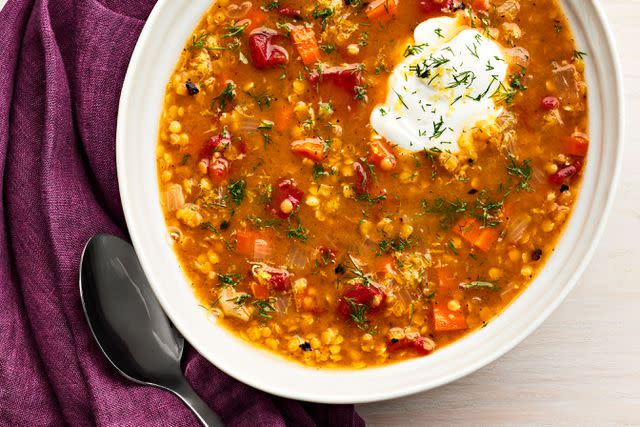
Victor Protasio
Red Lentil Soup With Lemon And Dill Recipe
Legumes like beans, peas, and lentils also contain decent amounts of zinc—alongside the protein, fiber, and other micronutrients they’re most known for. Peanuts are technically legumes and a great source of zinc as mentioned. Kidney beans are another excellent option offering 0.6 mg per half cup cooked, as are lentils with 1.3 mg in the same amount.
6. Meat
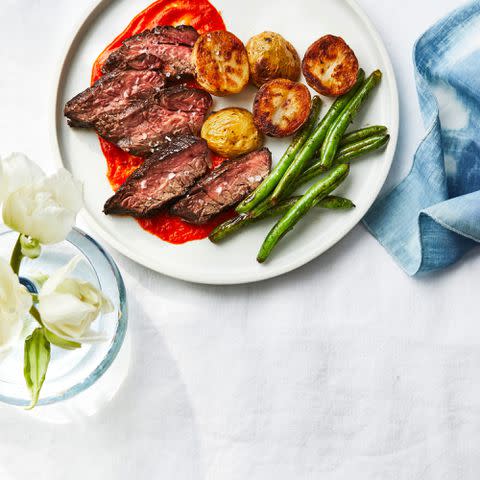
Hanger Steak With Roasted Red Pepper Sauce Recipe
While certain meat products like beef and pork can come with larger amounts of saturated fat, which needs to be consumed more sparingly, there’s no denying the nutrients found in animal proteins, zinc included. Beef is a particularly high source of the mineral with 3.8 mg per three ounces whereas pork provides 1.9 mg in the same amount.
Related: The Best Lean Protein Foods to Put on Your Plate—and Why They're So Good for You
7. Dairy
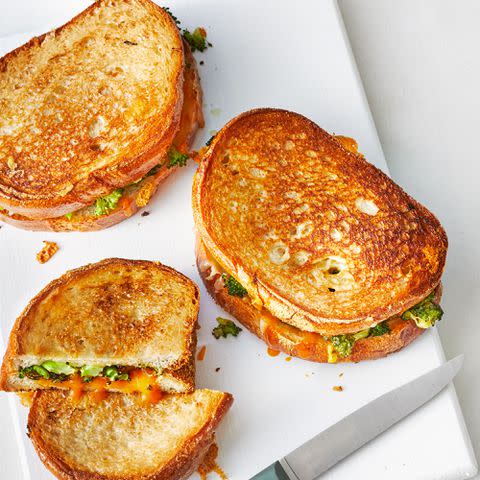
Broccoli-Cheddar Grilled Cheese
When it comes to zinc content, dairy wins out over dairy alternatives. One and a half ounces of cheese offers 1.5 mg of zinc, and both one cup of low-fat cow’s milk and six ounces of yogurt provide 1 mg each.
8. Certain Veggies Like Kale, Broccoli, and Tomatoes

Kale and Brussels Sprout Salad Recipe
Several vegetable options are higher in zinc: One cup of raw kale offers 0.3 mg of zinc, while broccoli boasts 0.4 mg per half cup cooked. Cherry tomatoes (technically a fruit!) also make the list offering 0.1 mg per half cup raw.
What About Zinc Supplements?
Supplements are another option your doctor or dietitian may recommend if you struggle to meet your daily zinc needs through food. However, it’s important to always choose brands that are third-party-verified by organizations like United States Pharmacopeia (USP) or the National Science Foundation (NSF) to best ensure purity and safety standards. This is important because the Food and Drug Administration (FDA) doesn’t regulate supplements in the same way they do food and medications, so there is less guarantee of quality and safety in these products.
Related: Should You Take a Multivitamin? We Asked a Doctor
For more Real Simple news, make sure to sign up for our newsletter!
Read the original article on Real Simple.

